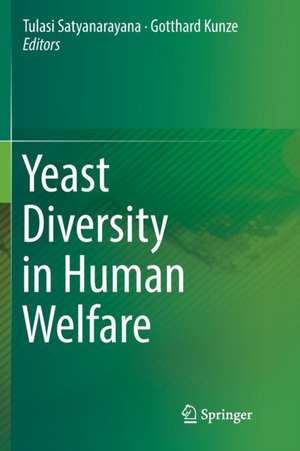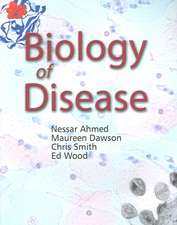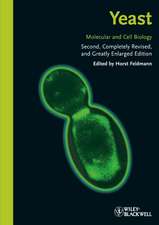Yeast Diversity in Human Welfare
Editat de Tulasi Satyanarayana, Gotthard Kunzeen Limba Engleză Paperback – 29 iul 2018
Yeasts are eukaryotic microfungi widely found in natural environments, including those with extreme conditions such as low temperatures, low oxygen levels and low water availability. To date, approximately 2,000 of the estimated 30,000 to 45,000 species of yeast on Earth, belonging to around 200 genera have been described. Although there are a few that are opportunistic human and animal pathogens, the vast majority of yeasts are beneficial, playing an important role in the food chain and in the carbon, nitrogen and sulphur cycles. In addition, yeasts such as Saccharomyces cerevisiae, Hansenula polymorpha and Pichia pastoris are used in expressing foreign genes to produce proteins of pharmaceutical interest.
A landmark in biotechnology was reached in 1996 with the completion of sequencing of the entire S.cerevisiae genome, and it has now become a central player in the development of an entirely new approach to biological research and synthetic biology. The sequencing of genomes of several yeasts including Schizosaccharomyces pombe, Candida albicans and Cryptococcus neofromans has also recently been completed.
| Toate formatele și edițiile | Preț | Express |
|---|---|---|
| Paperback (1) | 954.14 lei 6-8 săpt. | |
| Springer Nature Singapore – 29 iul 2018 | 954.14 lei 6-8 săpt. | |
| Hardback (1) | 960.42 lei 6-8 săpt. | |
| Springer Nature Singapore – 19 mai 2017 | 960.42 lei 6-8 săpt. |
Preț: 954.14 lei
Preț vechi: 1163.58 lei
-18% Nou
Puncte Express: 1431
Preț estimativ în valută:
182.60€ • 189.93$ • 150.74£
182.60€ • 189.93$ • 150.74£
Carte tipărită la comandă
Livrare economică 14-28 aprilie
Preluare comenzi: 021 569.72.76
Specificații
ISBN-13: 9789811096686
ISBN-10: 9811096686
Ilustrații: XIV, 486 p. 58 illus.
Dimensiuni: 155 x 235 mm
Greutate: 0.69 kg
Ediția:Softcover reprint of the original 1st ed. 2017
Editura: Springer Nature Singapore
Colecția Springer
Locul publicării:Singapore, Singapore
ISBN-10: 9811096686
Ilustrații: XIV, 486 p. 58 illus.
Dimensiuni: 155 x 235 mm
Greutate: 0.69 kg
Ediția:Softcover reprint of the original 1st ed. 2017
Editura: Springer Nature Singapore
Colecția Springer
Locul publicării:Singapore, Singapore
Cuprins
1.Diversity of natural yeast flora of grapes and its role in wine making in India.- 2. Yeast probiotics.- 3.Yeast phytases.- 4.Role of yeasts in food fermentations.- 5.Yeast expression system: Current practices and future perspectives.- 6.Biology of Killer yeast and technological implications.- 7.Yeast genetics as a powerful tool to study human diseases.- 8.Yeasts and traditional fermented foods and beverages.- 9. Yeast models for space biology.- 10. Biofilms of Candida.- 11. Ecology, diversity and applications of Saccharomyces cerevisiae used in food and beverage fermentations.- 12. Yeast proteomic applications.- 13. Applications of Kluyveromyces marxianus in food/biotechnology.- 14. Yeast as biocatalysts for synthesis of pure entianomeric alcohols, food with reduced purine content and enzymatic degradation of plastic materials.- 15. Conventional and non-conventional yeasts for the production of biofuels.- 16. High performance SBR-technology for unsterile fermentation of ethanol and other chemicals.- 17. Yeast to control aflatoxin production.- 18. Biotransformation and detoxification of environmental pollutants with aromatic structures by yeasts.- 19. Development of the thermotolerant methylotrophic yeast Hansenula polymorpha as efficient ethanol producer.- 20. Gene expression analysis in Arxula adeninivorans: A nested quantitative real time PCR approach.
Notă biografică
After obtaining M.Sc. and Ph.D. at the University of Saugar (India) T. Satyanarayana had post-doctoral stints at the Paul Sabatier University and National Institute of Applied Sciences, Toulouse, France. In 1988, he joined the Department of Microbiology, University of Delhi South Campus as Associate Professor and became Professor in 1998. His research efforts have been focused on understanding the diversity of yeasts, and thermophilic fungi and bacteria, their enzymes and potential applications, heterotrophic carbon sequestration and metagenomics. He has published over 250 scientific papers and reviews and edited six books. He has two Indian patents to his credit. He has been conferred with Dr. G.B. Manjrekar award of the Association of Microbiologists of India in 2004, Dr. V.S. Agnihotrudu award of Mycological Society of India in 2009 and Malaviya award of Biotech Research Society of India in 2012 for his distinguished contributions.
Gotthard Kunze studied biology at the Ernst Moritz Arndt University in Greifswald. He got a post-doctoral fellowship and a position as scientific assistant at the Department of Biology of the University. In 1986 he joined as a research associate at the Institute of Plant Genetics and Crop Plant Research (IPK), Gatersleben. Since 1998 he has been a Visiting Professor at the University of Greifswald and Professor at the Technical University Anhalt at Köthen since 1998. During this period, he focused his research activities on yeast genetics (construction of new yeast host vector systems, heterologous gene expression, thermo- and osmo-resistance in non-conventional yeasts and microbial yeast biosensors). Prof. Gotthard Kunze is the author of about 182 publications, editor of two books and teaches at the universities of Greifswald and Köthen.
Gotthard Kunze studied biology at the Ernst Moritz Arndt University in Greifswald. He got a post-doctoral fellowship and a position as scientific assistant at the Department of Biology of the University. In 1986 he joined as a research associate at the Institute of Plant Genetics and Crop Plant Research (IPK), Gatersleben. Since 1998 he has been a Visiting Professor at the University of Greifswald and Professor at the Technical University Anhalt at Köthen since 1998. During this period, he focused his research activities on yeast genetics (construction of new yeast host vector systems, heterologous gene expression, thermo- and osmo-resistance in non-conventional yeasts and microbial yeast biosensors). Prof. Gotthard Kunze is the author of about 182 publications, editor of two books and teaches at the universities of Greifswald and Köthen.
Textul de pe ultima copertă
This book brings together and updates the latest information on the diversity of yeasts, their molecular features and their applications in the welfare of mankind.
Yeasts are eukaryotic microfungi widely found in natural environments, including those with extreme conditions such as low temperatures, low oxygen levels and low water availability. To date, approximately 2,000 of the estimated 30,000 to 45,000 species of yeast on Earth, belonging to around 200 genera have been described. Although there are a few that are opportunistic human and animal pathogens, the vast majority of yeasts are beneficial, playing an important role in the food chain and in the carbon, nitrogen and sulphur cycles. In addition, yeasts such as Saccharomyces cerevisiae, Hansenula polymorpha and Pichia pastoris are used in expressing foreign genes to produce proteins of pharmaceutical interest.
A landmark in biotechnology was reached in 1996 with the completion of sequencing of the entire S.cerevisiae genome, and it has now become a central player in the development of an entirely new approach to biological research and synthetic biology. The sequencing of genomes of several yeasts including Schizosaccharomyces pombe, Candida albicans and Cryptococcus neofromans has also recently been completed.
Yeasts are eukaryotic microfungi widely found in natural environments, including those with extreme conditions such as low temperatures, low oxygen levels and low water availability. To date, approximately 2,000 of the estimated 30,000 to 45,000 species of yeast on Earth, belonging to around 200 genera have been described. Although there are a few that are opportunistic human and animal pathogens, the vast majority of yeasts are beneficial, playing an important role in the food chain and in the carbon, nitrogen and sulphur cycles. In addition, yeasts such as Saccharomyces cerevisiae, Hansenula polymorpha and Pichia pastoris are used in expressing foreign genes to produce proteins of pharmaceutical interest.
A landmark in biotechnology was reached in 1996 with the completion of sequencing of the entire S.cerevisiae genome, and it has now become a central player in the development of an entirely new approach to biological research and synthetic biology. The sequencing of genomes of several yeasts including Schizosaccharomyces pombe, Candida albicans and Cryptococcus neofromans has also recently been completed.
Caracteristici
Provides an update on the different aspects of yeast diversity and their utility Supports further research through exhaustive and lucid discussion of all the important aspects of yeast biology Explains how simple organisms like yeast can be utilized for human welfare Includes supplementary material: sn.pub/extras






